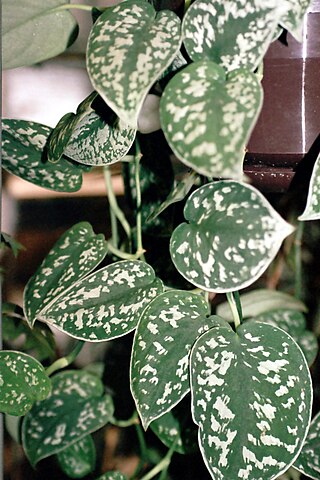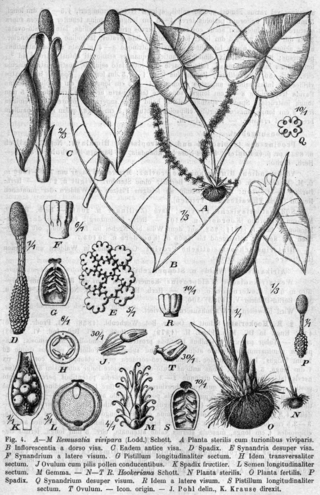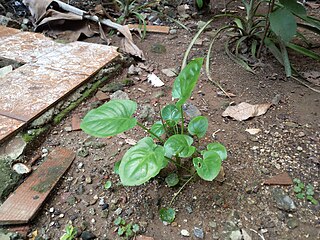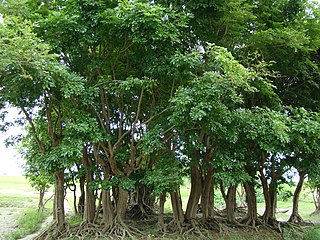
The Araceae are a family of monocotyledonous flowering plants in which flowers are borne on a type of inflorescence called a spadix. The spadix is usually accompanied by, and sometimes partially enclosed in, a spathe. Also known as the arum family, members are often colloquially known as aroids. This family of 140 genera and about 4,075 known species is most diverse in the New World tropics, although also distributed in the Old World tropics and northern temperate regions.

Amorphophallus is a large genus of some 200 tropical and subtropical tuberous herbaceous plants from the Arum family (Araceae), native to Asia, Africa, Australia and various oceanic islands. A few species are edible as "famine foods" after careful preparation to remove irritating chemicals. The genus includes the Titan arum of Indonesia, which has the largest inflorescence of any plant in the genus, and is also known as the 'corpse flower' for the pungent odour it produces during its flowering period, which can take up through seven years of growth before it occurs.

Cryptocoryne is a genus of aquatic plants from the family Araceae. The genus is naturally distributed in tropical regions of India, Southeast Asia and New Guinea.

Corypha umbraculifera, the talipot palm, is a species of palm native to eastern and southern India and Sri Lanka. It is also grown in Cambodia, Myanmar, China, Thailand and the Andaman Islands. It is a flowering plant with the largest inflorescence in the world. It lives up to 60 years before bearing flowers and fruits. It dies shortly after.

Dracontium is a genus of flowering plants similar to those of Amorphophallus. Unlike Amorphophallus which is found in the Old World, this genus has a New World distribution and is native to South America, Central America, southern Mexico, and the West Indies.

Epipremnum is a genus of flowering plants in the family Araceae, found in tropical forests from China, the Himalayas, and Southeast Asia to Australia the western Pacific. They are evergreen perennial vines climbing with the aid of aerial roots. They may be confused with other Monstereae such as Rhaphidophora, Scindapsus and Amydrium.

Scindapsus is a genus of flowering plants in the family Araceae. It is native to Southeast Asia, New Guinea, Queensland, and a few western Pacific islands. The species Scindapsus pictus is common in cultivation.

Remusatia is a genus of flowering plants in the family Araceae. It contains 4 known species, one of which was described in 1987. This species was initially placed in genus Gonatanthus called Gonatanthus ornatus. After the genus had been sunk into Remusatia its new name was Remusatia ornatus, but it was later changed to Remusatia hookeriana.
Porteresia coarctata is a species of grass in the family Poaceae, native to India, Sri Lanka, Bangladesh, and Myanmar.

Papilionanthe is a genus of flowering plants from the orchid family, Orchidaceae. It is native to Southeast Asia, southern China, and the Indian Subcontinent.

Typhonium flagelliforme is a species of flowering plant in the family Araceae.
Pseudocaryopteris is a genus of plants first described in 1999. It is native to China, Thailand, Myanmar, and the Himalayas.

Mickelopteris is a genus of ferns in the subfamily Cheilanthoideae of the family Pteridaceae with a single species Mickelopteris cordata. Synonyms include Parahemionitis cordata and Hemionitis cordataRoxb. ex Hook. & Grev. The species is native to south-eastern Asia, from India to Taiwan and the Philippines.
Calamus latifolius is a climbing plant, part of a subfamily, Calamoideae, whose members are usually called rattans in English, they are part of the Arecaceae, or palm, family.

Aeginetia is a genus of plants in the broomrape family Orobanchaceae, native mostly to tropical Asia and also Cameroon.

Eulophia obtusa, a showy and distinctive species of orchid, popularly known as the ground orchid, recorded from Bangladesh, North India and Nepal. This orchid growing in seasonally in grassland. It is a grass associated orchid species. A Bangladesh based renowned botanist and ornithologist Md Sharif Hossain Sourav first described this rare species from Bangladesh in 2017. There are only three collections in the Kew Herbarium dates from 1902, which suggests that it is quite a rare species. It is assessed as critically endangered (CR) in Bangladesh according to the IUCN Red Listing criteria. Very recently this species was rediscovered in India after 118 years.

Dalbergia reniformis is a wetland-dependent tree native to Bangladesh, India and Myanmar. It is a species of legume in the family Fabaceae.
Piper sylvaticum is a climber in the Piperaceae, or pepper, family. It is found in the northeast of the Indian subcontinent, and in Zhōngguó/China. The fruits are used in medicinal products.
Thepparatia is a monotypic genus of flowering plants belonging to the family Malvaceae. It only contains one known species, Thepparatia scandens(Roxb. ex G.Don) Phuph.

Scindapsus officinalis is a genus of flowering plants in the Araceae family. The species is native to the Indian subcontinent and Indo-China. The plant has local names such as pipul, gajpipul, and tiakathal.















